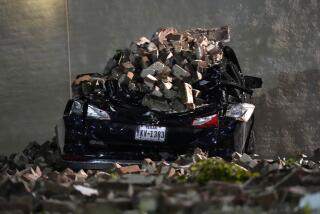Convoy of Envoys Starts Off Kosovo Monitoring
- Share via
PRISTINA, Yugoslavia — A high-profile diplomatic convoy on Monday toured areas of Kosovo hit by fighting earlier this year, kicking off an international monitoring program aimed at helping bring peace to this strife-torn region.
“The real patrolling will start toward the end of the week. . . . And at that point, it will be on a daily basis, and there will be many patrols each day,” said Richard Miles, the U.S. charge d’affaires in Belgrade, the capital of both Yugoslavia and Serbia, the larger of its two republics. Miles, together with Russia’s ambassador to Yugoslavia, headed the convoy in a bulletproof Chevrolet bedecked with American and Russian flags.
The nine diplomatic cars and more than 20 vehicles carrying journalists passed through three government roadblocks guarded by nervous Serbian police officers armed with AK-47 semiautomatic rifles. The convoy also passed by assorted government weaponry, including at least two armored personnel carriers and a heavy machine gun. But in its largely symbolic, 100-mile round-trip tour, it did not enter territory held by the Kosovo Liberation Army, the rebel group that is demanding independence for Kosovo.
That loosely organized ethnic Albanian guerrilla force controls about one-third of the territory of Kosovo, a southern Serbian province about the size of Los Angeles County that has a 90% ethnic Albanian majority.
At least 40 diplomatic and military experts who nominally will be attached to embassies in Belgrade are due to be stationed in Kosovo by mid-July to monitor the conflict between secessionist-minded ethnic Albanians and the Yugoslav government’s primarily Serbian security forces. These monitors are expected to include about 12 to 15 Americans, four of whom have already arrived here.
The more serious patrols with military experts are expected to enter rebel-held territory. A key purpose of the patrols will be to deter attacks on civilians by the forces of either side.
The diplomats in Monday’s convoy stopped at the village of Donji Prekaz for a firsthand look at the kind of destruction the observer mission is hoping to prevent. A March assault on the village by Serbian police killed about 80 ethnic Albanians, including children.
That action sent a wave of fresh recruits into the rapidly growing Kosovo Liberation Army, or KLA, and helped ignite a wave of nearly daily skirmishes between the group and government forces. At least 300 people have been killed in the fighting, and tens of thousands have fled their homes.
Donji Prekaz, 20 miles southwest of Pristina, the provincial capital, has changed little since the March fighting ended, except that new grass and weeds cover the hillside graves of some of those who were slain. The village remains a ghost town of ruined houses and overgrown fields.
*
In addition to Miles and Russian Ambassador Yuri Kotov, Monday’s convoy included ambassadors or other high-level diplomats from France, Italy, Norway, Poland and other countries. Most viewed their effort as a success.
Kotov said he was “satisfied with the mission, and I believe it will be better next time.” The patrols will be a “stabilizing factor” in Kosovo, he added.
French Ambassador Stanislas Filliol said that the role of diplomatic observers “has been well understood by the two parties, which is very encouraging. . . . And I think they will gradually reduce the fighting.”
In other parts of Kosovo, however, clashes continued Monday, according to conflicting reports.
The ethnic Albanian-run Kosovo Information Center, for example, said that Serbian forces had shelled the village of Lodja.
The Serbian-run Media Center in Pristina countered that “this morning at 6:30, a heavily armed group of Albanians fired automatic weapons against the houses of . . . families in Lodja village.”
*
Times special correspondent Dejan Pavlovic in Pristina contributed to this report.
More to Read
Sign up for Essential California
The most important California stories and recommendations in your inbox every morning.
You may occasionally receive promotional content from the Los Angeles Times.











